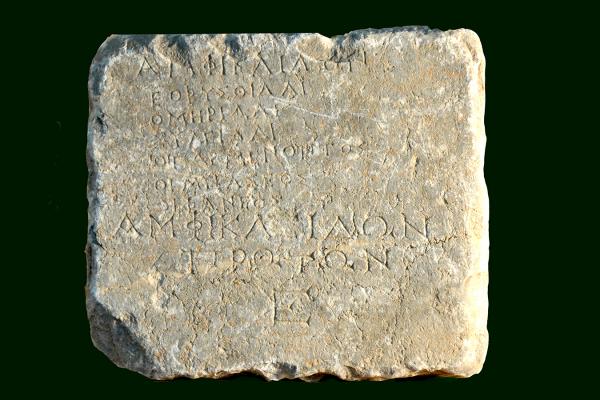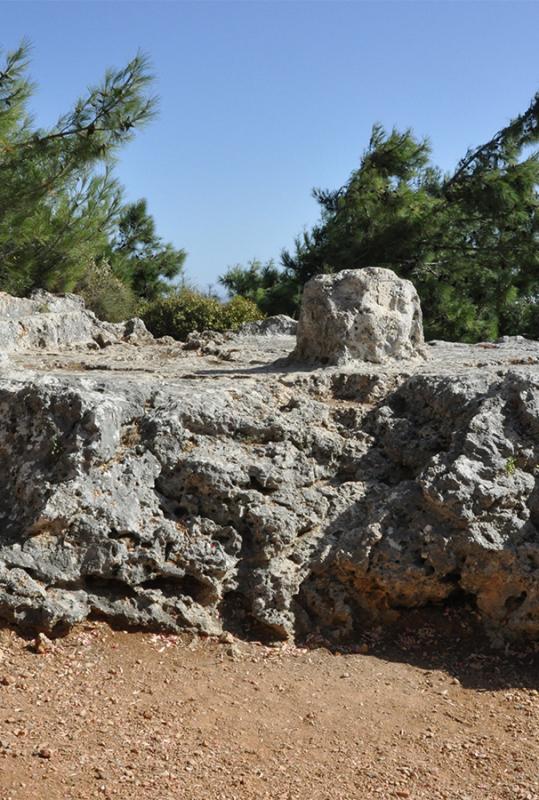According to myth, this was the location of the School of Homer. The poet had his throne at the edge of the cliff, where he taught his students, and this is why the area was named Daskalopetra (‘the rock of the teacher’). However, archaeological and historic research identifies Daskalopetra with the open-air sanctuary of the goddess Cybele, protector of fertility and nature, who was strongly worshipped at Chios. The monument lay on the rock and it has been identified as the goddess’s monolithic statue-temple. Today it is severely damaged and corroded. All that remains is the female figure in relief, sitting on a throne, as well as traces of the body and paws of the lions that flanked its other three sides. The monument dates in the late 6th c. B.C. and it is suggested that it was dedicated to Cybele by a rich resident of the island or by the city of Chios, seeking the goddess’s grace.
7. PART B. Daskalopetra
Daskalopetra, or the Rock of Homer lies at a distance of 7 kilometers from the city of Chios. It is said that the poet would sit at that rock to teach his students and recite his poems.
Stories
The altar of Goddess Cybele
Homer’s descendants
The Homerides were rhapsodists from Chios who had the privilege of the exclusive citation of the Homeric epics, as they supported that they were the poet’s descendants. In the 5th c. B.C Acusilaos of Argos, one of the first Greek mythographers and logographers, mentions the Homerides as Homer’s descendants. Pindar, Plato and Isocrates also deem them as rhapsodists. In 1520 the French monk and traveler André Thevet mentioned that “the people of Chios brag and take pride in the fact that [Homer] came from their island, because the ancient relied on the fact that there existed a clan called Homerides, fine reciters who would create clever and beautiful verses”. Adamantios Korais considered it highly unlikely that they would literally draw their descent from Homer; still, he suggested that the Homerides rightly believed that they carried on the poet’s tradition, as they preserved and propagated his work after his death.
Recording the Homerides

The Archaeological Museum of Chios has in its collection an inscription mentioning the house of the Homerides. It was discovered in the fortress of Chios in the 1960s and it is the first inscribed testimony mentioning the Homerides as a clan coming from the island of Chios. Discovering the inscription at that specific location, as well as the fact that, according to tradition, Homer had lived in Chios and left descendants behind, have led researchers to suggest that the Homerides indeed came from the poet and lived in the ancient city of Chios, which lay at the same geographic location as its modern counterpart.
Villa Homerica
At a close distance from Daskalopetra was located the luxurious villa Homerica belonging to the Italian Andriolo Banca Giustiniani, whose family, one of the most powerful in Genoa, dominated Chios for more than 2 centuries (1346-1566). Researchers suggest that he named it Homerica because he was influenced by the region’s history. Italian traveler Cyriacus of Ancona described the villa in great admiration, when Giustiniani invited him to the island. At the same mansion, Andriolo Giustiniani’s son, Angelo, welcomed Christopher Columbus in 1474. The Italian explorer navigator visited the island in search of skilled sailors and sailing maps, for the journey that would lead him to discover America. Tip: During your visit at Pyrgi, don’t forget to see the house where, according to tradition, Columbus stayed during his sojourn on the island. The surname Kolombos is popular in Pyrgi – yet another piece of evidence, as many believe, for a connection between the explorer and Chios.
Powered by Clio Muse Tours
